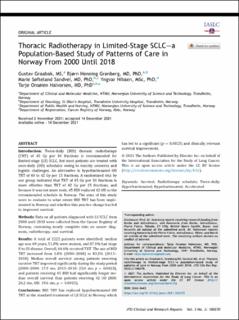| dc.contributor.author | Graabak, Gustav | |
| dc.contributor.author | Grønberg, Bjørn Henning | |
| dc.contributor.author | Sandvei, Marie Søfteland | |
| dc.contributor.author | Nilssen, Yngvar | |
| dc.contributor.author | Halvorsen, Tarje Onsøien | |
| dc.date.accessioned | 2023-02-09T11:44:07Z | |
| dc.date.available | 2023-02-09T11:44:07Z | |
| dc.date.created | 2022-04-25T11:02:22Z | |
| dc.date.issued | 2022 | |
| dc.identifier.citation | JTO Clinical and Research Reports. 2022, 3 (2), . | en_US |
| dc.identifier.uri | https://hdl.handle.net/11250/3049647 | |
| dc.description.abstract | Introduction
Twice-daily (BID) thoracic radiotherapy (TRT) of 45 Gy per 30 fractions is recommended for limited-stage (LS) SCLC, but most patients are treated with once-daily (OD) schedules owing to toxicity concerns and logistic challenges. An alternative is hypofractionated OD TRT of 40 to 42 Gy per 15 fractions. A randomized trial by our group indicated that TRT of 45 Gy per 30 fractions is more effective than TRT of 42 Gy per 15 fractions, and because it was not more toxic, 45 BID replaced 42 OD as the recommended schedule in Norway. The aims of this study were to evaluate to what extent BID TRT has been implemented in Norway and whether this practice change has led to improved survival.
Methods
Data on all patients diagnosed with LS SCLC from 2000 until 2018 were collected from the Cancer Registry of Norway, containing nearly complete data on cancer diagnosis, radiotherapy, and survival.
Results
A total of 2222 patients were identified; median age was 69 years, 51.8% were women, and 87.1% had stage II to III disease. Overall, 64.6% received TRT. The use of BID TRT increased from 1.8% (2000–2004) to 83.2% (2015–2018). Median overall survival among patients receiving curative TRT improved significantly during the study period (2000–2004: 17.9 mo, 2015–2018: 25.0 mo, p = 0.0023), and patients receiving 45 BID had significantly longer median overall survival than patients receiving 42 OD (BID: 26.2 mo, OD: 19.6 mo, p = 0.0015).
Conclusions
BID TRT has replaced hypofractionated OD TRT as the standard treatment of LS SCLC in Norway which has led to a significant (p = 0.0023) and clinically relevant survival improvement.
Previous article in issue | en_US |
| dc.language.iso | eng | en_US |
| dc.publisher | Elsevier Science | en_US |
| dc.rights | Navngivelse 4.0 Internasjonal | * |
| dc.rights.uri | http://creativecommons.org/licenses/by/4.0/deed.no | * |
| dc.title | Thoracic Radiotherapy in Limited-Stage SCLC—a Population-Based Study of Patterns of Care in Norway From 2000 Until 2018 | en_US |
| dc.title.alternative | Thoracic Radiotherapy in Limited-Stage SCLC—a Population-Based Study of Patterns of Care in Norway From 2000 Until 2018 | en_US |
| dc.type | Peer reviewed | en_US |
| dc.type | Journal article | en_US |
| dc.description.version | publishedVersion | en_US |
| dc.source.volume | 3 | en_US |
| dc.source.journal | JTO Clinical and Research Reports | en_US |
| dc.source.issue | 2 | en_US |
| dc.identifier.doi | 10.1016/j.jtocrr.2021.100270 | |
| dc.identifier.cristin | 2018841 | |
| dc.source.articlenumber | 100270 | en_US |
| cristin.ispublished | true | |
| cristin.fulltext | original | |
| cristin.qualitycode | 1 | |

